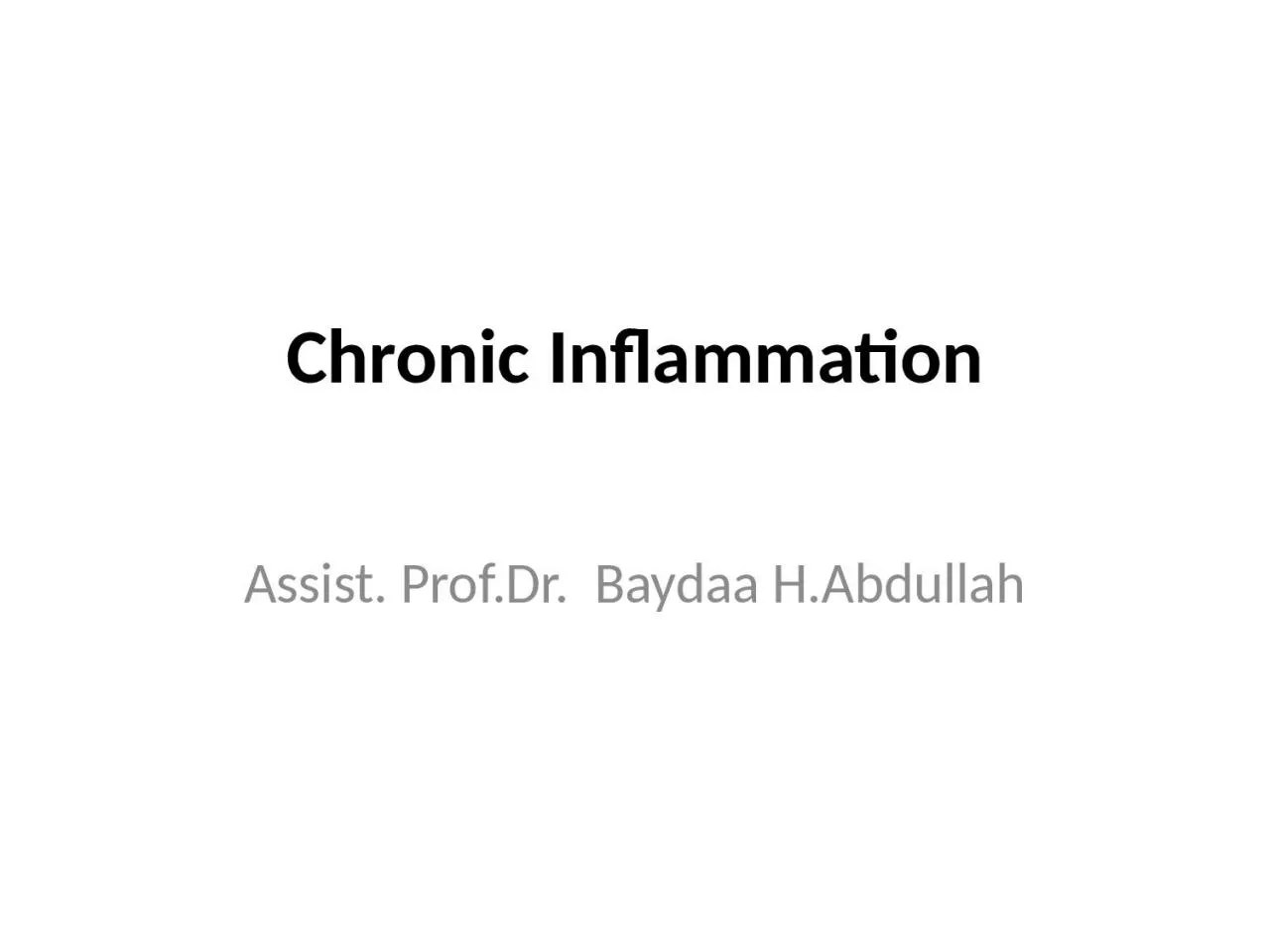

ProfDr Baydaa HAbdullah Chronic Inflammation An immune reaction to some mild but persistent antigen producing proliferation of Lymphocytes andor plasma cells There are usually no pain redness swelling or warmth ID: 928930
Download Presentation The PPT/PDF document "Chronic Inflammation Assist." is the property of its rightful owner. Permission is granted to download and print the materials on this web site for personal, non-commercial use only, and to display it on your personal computer provided you do not modify the materials and that you retain all copyright notices contained in the materials. By downloading content from our website, you accept the terms of this agreement.
Slide1
Chronic Inflammation
Assist.
Prof.Dr
.
Baydaa
H.Abdullah
Slide2Chronic Inflammation
:
An immune reaction to some mild but persistent antigen producing proliferation of Lymphocytes and/or plasma cells
.
There are usually no pain, redness, swelling, or warmth
.
Slide3General features of chronic inflammation
-Chronic inflammation is characterized by
gradual onset
and prolonged duration.
-The signs and symptoms are not as sever as those of acute phase.
Slide4Time course
:
Greater than 48hours (weeks, months, years
).
•
Cell type
Mononuclear cells(Macrophages, Lymphocytes ,Plasma cells),
eosinophils,f
ibroblasts
and collagen
Slide5The etiology and pathogenesis of Chronic inflammation
-Persistent acute inflammation chronic.
-Low grad irritation may initiate chronic inflammation.
-Micro-organisms with low virulence (Tb, viruses) may initiate chronic inflammation.
-Constant stimulation of immune system may initiate chronic inflammation ( autoimmune diseases, rheumatoid arthritis).
Slide6Causes of chronic inflammation
Persistent infections
Organisms usually of low toxicity that invoke delayed hypersensitivity reaction
M. tuberculosis
and
T. pallidum
causes granulomatous reaction
Prolonged exposure to potentially toxic agents
Exogenous agents include silica which causes silicosis
Endogenous causes include atherosclerosis caused by toxic plasma lipid components
Autoimmunity
Auto-antigens provoke self-perpetuating immune responses that cause chronic inflammatory diseases like RA, MS
Responses against common environmental substances cause chronic allergic diseases, such as bronchial asthma
Slide7Cells of chronic inflammation
Histologically
chronic inflammation includes
:
Macrophages,Lymphocytes,and
Plasma cells.
Proliferation of fibroblasts and small blood vessels(revascularization
).
Increased connective tissue(fibrosis
)
Tissue destruction
.
Slide8Cells of the chronic inflammatory response
Lymphocytes
Monocytes/ macrophages
Plasma cells
Slide9Macrophage-lymphocyte interactions
in chronic inflammation
Slide10Mononuclear phagocytes (Macrophages/MOs/
Histiocytes
)
•The PMN is central to acute inflammation.
•The macrophage (MOs) is central to chronic inflammation.
Slide11Maturation of mononuclear phagocytes
Slide12Macrophage origin
MQs
come from the same cell line (
monocytes
), but differ depending on their microenvironment
Slide13Granulomatous inflammation:
a special form of
chronic inflammation
Slide14Granuloma
Definition
A collection of macrophages, lymphocytes, mononuclear cells and fibroblasts with or without giant cell formation and constitutes a special form of chronic inflammation
Slide15Slide16MQ functions
1.Produce
toxic, biologically active substances such as oxygen metabolites.
2.Cause influx of other cells such as other macrophages and lymphocytes.
3.Cause fibroblast proliferation and collagen deposition.
4.Phagocytosis.
Slide17MQs accumulation
Three
ways in which
MQs
accumulate
1.Continued recruitment from the circulation, secondary to
chemotactic
factors
.
2.Division.
3.Prolonged
survival,and
immoblization
.
Slide18Mechanisms of macrophage accumulation in tissues.The most important is continued recruitment from the
microcirculation
Slide19Other cells in chronic inflammation
•
Lymphocytes: T-cells are the characteristic cells that can activate macrophages.
•
Plasma cells: secrete antibodies against specific antigens.
•
Eosinophils
: can destroy parasites and certain cells. Also they are accumulated in allergic diseases.
Slide20Multinucleate giant cells: huge cells with many nuclei formed by fusion of macrophages. They are associated with foreign materials or accompany reactions to certain organisms
asTB
.
Fibroblasts and collagen: Collagen production is a common feature of chronic inflammation. Chemical mediators stimulate collagens
ecreting
cells and fibrosis
Slide21Granulomatous inflammation
Focus of chronic inflammation encountered in a limited number of conditions
Cellular attempt to contain a foreign body or an offending agent that is difficult to eradicate (i.e. Tb)
Microscopic aggregation of macrophages that are transformed into
epithelioid
cells, surrounded by a collar of lymphocytes and occasionally plasma cells
Epithelioid
cells have a pale pink granular cytoplasm with indistinct cell boundaries, often merging as giant cells
Foreign body
epitheloids
have dispersed nuclei
Infectious body
epitheloids
have marginal or horse-shoe nuclei
Enlarged
granuloma
with central necrosis is an
abcess
Enlarged
granuloma
on a surface is an ulcer
Slide222nd Yr Pathology 2010
Macrophage-lymphocyte interactions
in chronic inflammation
Slide23Outcome of chronic inflammation
Resolution/regeneration/restitution
of normal structure.
Repair/organization/healing
by connective tissue/ fibrosis/ scarring.
It
can continue indefinitely--some disease processes are capable of continuing indefinitely such as rheumatoid arthritis..
Slide24Chronic GranulomatousInflammation
(GI)
Definition: a type or pattern of chronic inflammation defined by the presence of
granulomas
which are small,0.5 to 2mm collections of modified "
epithelioid
“
histiocytes
/macrophages and (
Langhan's
)giant cells (fused
histiocytes
) , with a background of new capillaries , fibroblasts, and new collagen , usually surrounded by a rim of lymphocytes
Slide25Granulomas
occur
in response to various diseases
Foreign
body
Tuberculosis
(Tb)
Fungal
(
mycotic
) infections
Slide26Two factors necessary for granuloma formation
Presence
of
indigestible organisms
or particles (Tb, mineral oil, etc)
Cell
mediated immunity (T
cells).
Slide27Chronic
inflammation
Knee joint in rheumatoid arthritis
Slide28Chronic inflammation: tissue effects
Chronic cervicitis
Slide29Granulomatous inflammation
Bacterial
:
TB, Leprosy, Syphillis, cat-scratch disease
Parasitic
:
Schistosomiasis
Fungal
:
Histoplasma, blastomycosis, cryptococcus
Inorganics, metals, dusts
:
Silicosis, berrylliosis
Foreign body
Unknown
:
Sarcoidosis
Slide30Granulomatous inflammation: tissue effects
Slide31Granulomatous inflammation: tissue effects
Slide32Granulomatous inflammation: tissue effects
Slide33Granulomatous inflammation: tissue effects
Epithelioid cells
Slide34Granulomatous inflammation: tissue effects
Talc granulomas in the lung
Slide35Acute Vs
Chronic
Flush
, Flare &
Weal Little
signs -Fibrosis
Acute
inflammatory
cells
Chronic inflammatory
cells
-
Neutrophils
–Lymphocytes
Vascular damage Neo-
vascularisation
More exudation
No/less exudation
Little
or no
fibrosis
Prominent fibrosis